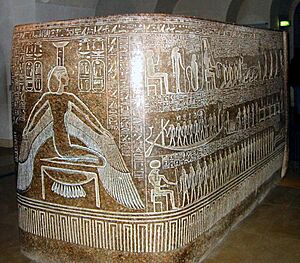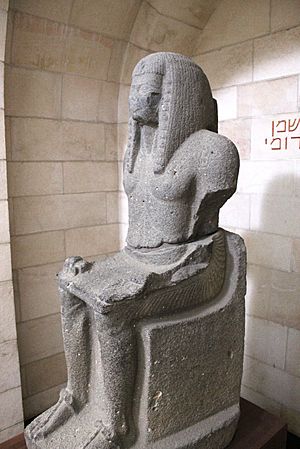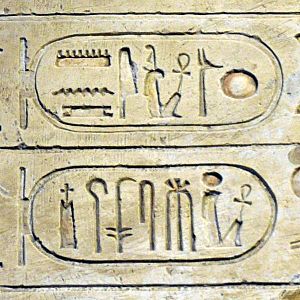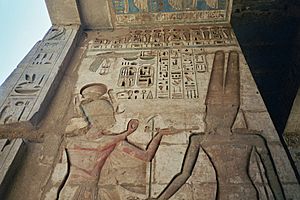Ramesses III facts for kids
Quick facts for kids Ramesses III |
|
|---|---|
| Ramses III, Rameses III | |

Relief from the sanctuary of the Temple of Khonsu at Karnak depicting Ramesses III
|
|
| Pharaoh | |
| Reign | 1186–1155 BC (20th Dynasty) |
| Predecessor | Setnakhte |
| Successor | Ramesses IV |
| Consort | Tyti, Isis Ta-Hemdjert, Tiye |
| Children | By Tyti:
By Tiye:
|
| Father | Setnakhte |
| Mother | Tiy-Merenese |
| Born | 1217 BC |
| Died | 1155 BC (aged 61-62) |
| Burial | KV11 |
| Monuments | Medinet Habu |
Ramesses III was an important Pharaoh (king) of Ancient Egypt. He was the second ruler of the Twentieth Dynasty. People believe he ruled from March 1186 BC to April 1155 BC. He is often seen as the last powerful king of the New Kingdom of Egypt.
During his long time as pharaoh, Egypt's power and wealth started to decrease. This was because of attacks from other groups and money problems. But Ramesses III was a strong leader. He successfully defended Egypt from invaders, especially a group called the "Sea Peoples". These invaders had caused a lot of trouble for other empires. Ramesses III saved Egypt from falling apart when many other empires did during the Late Bronze Age.
Ramesses III also built a very large temple for himself in western Thebes. It is now called Medinet Habu. He was the son of Setnakhte and Tiy-Merenese. Sadly, he was killed in a plot led by one of his wives, Tiye, and her son Pentawere. After his death, his son Ramesses IV became the next pharaoh.
Contents
Ramesses III: His Royal Names
Ramesses III had two main royal names. These names meant "The Ma'at (truth and order) of Ra is strong, Beloved of Amun" and "Born of Ra, Ruler of Heliopolis". These names showed his connection to important Egyptian gods and cities.
Becoming Pharaoh: Ramesses III's Accession
Ramesses III became pharaoh in March 1186 BC. He ruled for about 31 years, 1 month, and 19 days. His rule ended in April 1155 BC.
When he became king, four doves were sent to the four directions. This was a way to show that Ramesses III was truly the pharaoh. It also meant that order and balance (Ma'at) were strong in Egypt.
A Time of Battles: Ramesses III as a Warrior Pharaoh
Ramesses III ruled during a very chaotic time. Many empires around Egypt were collapsing. Egypt faced attacks from foreign groups like the Sea Peoples and the Libyans. Egypt also started having money problems and internal conflicts.
In his 8th year as pharaoh, the Sea Peoples attacked Egypt by land and sea. This group included different tribes like the Peleset and Shardana. Ramesses III fought them in two big battles. First, he defeated them on land in a place called Djahy, which is in modern-day southern Lebanon.
Then, he defeated them at sea in the Battle of the Delta. Ramesses led the Sea Peoples' ships into the mouth of the Nile River. He had a fleet of Egyptian ships waiting in ambush. Even though Egyptians were not known as great sailors, they fought very hard. Ramesses had archers along the riverbanks. They shot arrows at the enemy ships as they tried to land. Then, the Egyptian navy used hooks to pull in the enemy ships. In the fierce hand-to-hand fighting, the Sea Peoples were completely defeated.
A famous ancient document, the Harris Papyrus, describes this victory. It says that those who reached Egypt's border were destroyed forever. Those who came by sea were met with fire at the Nile mouths. They were surrounded by spears on the shore, killed, and piled up.
Ramesses III made some of the Sea Peoples live in southern Canaan. Their presence there might have helped new states like Philistia form later. Ramesses III also had to fight Libyan tribesmen. He fought them in two major campaigns in Egypt's Western Delta in his 5th and 11th years as pharaoh.
Egypt's Economic Challenges Under Ramesses III
The many wars cost Egypt a lot of money. This slowly weakened the Egyptian Empire. These difficulties were so serious that the first known labor strike in history happened during Ramesses III's 29th year. This happened when the workers who built royal tombs in a village called Deir el-Medina did not get their food.
Something in the air, possibly a big volcanic eruption (the Hekla 3 eruption), might have blocked sunlight. This could have affected crops and caused food prices to rise. This made it harder for Ramesses III to provide food for his workers.
Even with these problems, Ramesses III built many impressive monuments. He added important parts to the temples at Luxor and Karnak. His own temple at Medinet-Habu is one of the largest and best-preserved in Egypt. However, this temple also shows the challenges of his time. It had strong fortifications, which was unusual for a temple in the heart of Egypt. This shows that the pharaoh felt a need to protect it.
The Plot Against Ramesses III
We know about a plot against Ramesses III because of ancient court documents called trial transcripts. This plot happened during a celebration at Medinet Habu. It was started by Tiye, one of his wives. She wanted her son, Pentaweret, to become pharaoh instead of Ramesses IV, who was the chosen successor.
The trial documents show that many people were involved in the plot. These included Queen Tiye, her son Pentaweret, and many royal officials. Most of the main plotters were put to death. Their tombs were robbed, and their names were removed from records. This was done to prevent them from having an afterlife.

Ramesses IV, the king's chosen son, became pharaoh after his father's death. This happened even though Pentaweret was supposed to benefit from the plot. Ramesses III died in his 32nd year as pharaoh, the same year the plotters were tried and punished.
For a long time, people thought Ramesses III's body showed no clear injuries. But in 2011, a special scan (CT scan) of his mummy showed something different. It revealed a deep knife wound across his throat, hidden by bandages. Later, another study of the scan showed that his left big toe was also likely chopped off by a sharp object. These injuries happened just before he died. The embalmers even put a linen object in place of the missing toe. These findings strongly suggest that Ramesses III was indeed killed in the plot, possibly by several attackers.
Even though the plotters succeeded in killing the pharaoh, they failed to change who would rule next. The crown went to Ramesses IV, just as Ramesses III had planned.
DNA Studies and Family Connections
Scientists have studied the DNA of Ramesses III's mummy. They also studied the mummy of an unknown man found with him. These studies showed that the two mummies were father and son. This unknown man is believed to be Pentaweret, the son who was part of the plot against Ramesses III. The way Pentaweret's body was mummified also suggested he had been punished.
These DNA studies help us understand the family relationships of ancient Egyptian pharaohs.
Ramesses III's Legacy: What He Left Behind
The Great Harris Papyrus is a very long ancient document. It was ordered by Ramesses IV, Ramesses III's son. This papyrus lists all the land, gold statues, and buildings that Ramesses III gave to Egypt's temples. These temples were in important cities like Piramesse, Heliopolis, and Karnak.
The papyrus also tells us that Ramesses III sent a trading trip to the Land of Punt. He also mined copper in Timna, a place in southern Canaan. The papyrus says:
I sent my messengers to the land of Atika, [i.e., Timna] to the great copper mines there. Their ships carried them, and others went by land on their donkeys. This had not been heard of since the time of any earlier king. Their mines were found and [they] yielded copper which was loaded by tens of thousands into their ships, they being sent in their care to Egypt, and arriving safely.
Ramesses III started rebuilding the Temple of Khonsu at Karnak. He also finished his own funeral temple and administrative complex at Medinet Habu around his 12th year as pharaoh. He decorated the walls of his Medinet Habu temple with scenes of his battles against the Sea Peoples. This temple is still one of the best-preserved temples from the New Kingdom.
Ramesses III's mummy was found in 1886. His tomb (KV11) is one of the largest in the Valley of the Kings. In April 2021, his mummy was moved to the National Museum of Egyptian Civilization in a special event called the Pharaohs' Golden Parade.
Gallery
-
Ramesses III prisoner tiles: Inlay figures, faience and glass, of "the traditional enemies of Ancient Egypt" from Medinet Habu, at the Museum of Fine Arts, Boston. From left: 2 Nubians, Philistine, Amorite, Syrian, Hittite
-
A painted ceiling of Nekhbet at Ramesses III's mortuary temple at Medinet Habu.
-
Ramesses III talking with the Theban Triad: Amun, Mut and Khonsu. The ‘Great Harris Papyrus’ at the British Museum, c. 1150 BC. Image taken from the book The Search for Ancient Egypt (p. 91) by Jean Vercoutter.
See also
 In Spanish: Ramsés III para niños
In Spanish: Ramsés III para niños












